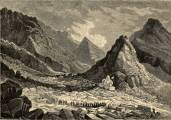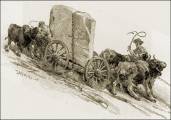


The Maine Stone Industry, 1908
Excerpts from
Mineral Resources of the United States, Calendar Year
1908,
Part II - Nonmetallic Products,
Department of the Interior, United States Geological
Survey,
Government Printing Office,
Washington, D. C., 1909.
Excerpts from the book are from the chapters on: 1) Slate, by A. T. Coons, and 2) Stone, by A. T. Coons.
Building Stone Distribution: "Distribution of the various kinds of building stone and the localities where the different varieties of stone are now being quarried or may be quarried in the future for Maine are: Soapstone, serpentine (verdantique marble), granite, gneiss, diabase, norite, gabbro, quartz, porphyry, sandstone, slate.
Production: "In 1908, as in 1907, nine States reported a commercial output of slate. These States in rank of output were Pennsylvania, Vermont, Maine, Virginia, New York, Maryland, California, New Jersey, and Arkansas. In 1907 the rank of output was Pennsylvania, Vermont, Maine, Virginia, Maryland, New York, California, Arkansas, and New Jersey. New York displaced Maryland and New Jersey displaced Arkansas in 1908.
"All of the States except Maryland reported an increased production for roofing slate, both in quantity and value, in 1908. The decrease in Maryland was due largely to a slide in one of the chief quarries, resulting in a decrease of output for that quarry and for the state.
Mill stock: "The value of mill stock, including slate sold for all purposes other than roofing, decreased from $1,201,451 in 1907 to $1,130,650 in 1908, a decline of $70,801. The quarries of Pennsylvania, Vermont, and Maine furnish nearly all of the mill stock. Vermont decreased in quantity of output, and Pennsylvania and Maine decreased both in quantity and in value.
Slate: "The principal Maine slate deposits are in Piscataquis County, near the towns of Monson, Blanchard, and Brownville. Commercial slate, however, occurs near the town of Forks, Somerset County, but as this deposit has been open to the railroad only a short time no slate has been marketed.
"The roofing slate production in this State increased somewhat in 1908, from 16,879 squares, valued at $91,583, in 1907 to 20,151 squares, valued at $115,682, in 1908, an increase of 3,272 squares in quantity and of $24,099 in value. The producers in general reported an increase in roofing slate, with better prices. Mill stock demand was, however, reported very dull, and this is evident from the decrease in production of 119,530 square feet in quantity and of $46,998 in value-from 404,829 square feet, valued at $145,023 in 1907 to 285,299 square feet, valued at $98,025 in 1908.
"The following results of various tests of Maine (Monson) slate made at the United States Arsenal at Watertown, Mass., were republished from the War Department reports in the Twentieth Annual Report of the United States Geological Survey, Part VI (continued), 1899, page 395:
| Pounds | ||
| Maximum fiber stress per square inch | 7,671 | |
| Shearing test per square inch | 2,192 | |
| Ultimate compressive strength per square inch | 19,510 | |
| Coefficient of expansion, 0.000005 | ||
"., the slates in the United States include a very wide range of varieties dependent upon color, texture, fissility, composition, etc. While nearly all of them possess one or two excellent features, few possess many such features, and none possess them all. the very dark gray unfading roofing slates of the Peach Bottom district in Maryland and Pennsylvania, of Arvonia in Virginia, and of Brownville and Monson in Maine, which owe the durability of their shade to sparseness of carbonate and in cases to the presence of graphite, and their general qualities to a very high degree of metamorphism; the very dark gray mill-stock slates of Northfield in Vermont and of Monson in Maine, and the greenish and purplish mill-stock slates of Vermont; and lastly the "sea green" roofing slates of Vermont, and the very dark gray roofing slates of Northampton and Lehigh counties in Pennsylvania, which, owing to their abundant carbonate, fade more or less, sooner or later, but are less expensive.
Granite: "In 1907 the rank in output of States producing granite to the value of $500,000 or more was Vermont, Massachusetts, Maine, California, Wisconsin, Maryland, North Carolina, Georgia, Rhode Island, New Hampshire, Connecticut, Washington, and Minnesota; in 1908, Vermont, Maine, Massachusetts, California, Wisconsin, Georgia, Washington, New Hampshire, North Carolina, Maryland, Minnesota, Connecticut and Rhode Island decreased in value of production.
"In 1907 there were six States with an output valued at over $1,000,000. In 1908 Maryland dropped below $1,000,000, and Maine exchanged places with Massachusetts, although the production was almost identical for the two States.."
"In 1907 there were six States with an output valued at over $1,000,000. In 1908 Maryland dropped below $1,000,000, and Maine exchanged places with Massachusetts, although the production was almost identical for the two States.Maine increased in building stone and paving blocks, but decreased in monumental stone.."
Granite Building Stone: "The rough building stone sold by the granite quarrymen was valued at $1,379,106 in 1908, and at $1,280,769 in 1907, an increase of $98,337 in this class of material. Maine, Pennsylvania, Massachusetts, Maryland, and North Carolina reported the greatest values for rough building stones sold, all these States reporting a decreased output except Maryland and North Carolina, which increased in value for this product.
"The dressed stone sold for building by the quarrymen was valued at $4,372,152 in 1908 and at $4,752,593 in 1907, a decrease of $380,441. In 1907 the decrease was $1,906,511 compared with 1906. In 1907 for this output the report was as follows: Vermont, $1,009,353; Maine, $1,007,572; Massachusetts, $907,119; California, $485,778. There was therefore, in 1908, an increase of $48,417 for Maine and of $234,055 for California, and a loss of $333,286 for Vermont and of $186,323 for Massachusetts.
Granite Paving blocks: "The paving-block industry increased in value from $1,928,308 in 1907, to $4,420,555 in 1908, a gain of $492,247. Wisconsin, Maine, and Massachusetts were the largest producers of this class of material.
Granite Curbstone: "Granite curbing in 1908 was valued at $942,722, and in 1907 at $819,621, a gain of $123,101 for 1908. Georgia, California, North Carolina, Massachusetts, and Maine were the largest curbstone-producing states in 1908."
Excerpt from the Bibliography for Maine:
Dale, T. N., Note on a new variety of Maine slate. In Bulletin No. 285, pp. 449-450. 1906. 60c.
Dale, T. N., The granites of Maine. Bulletin No. 313. 202 pp. 1907.
Leighton, Henry, and Bastin, E. S. Road materials of southern and eastern Maine. Bulletin No. 33, Office of Public Roads, Department of Agriculture. 1908. (May be obtained from Department of Agriculture.)
Smith, G. O. The granite industry of the Penobscot Bay district, Maine. In Bulletin No. 260, pp. 489-492. 40c.
Commercial use of material within this site is strictly prohibited. It is not to be captured, reworked, and placed inside another web site ©. All rights reserved. Peggy B. and George (Pat) Perazzo.